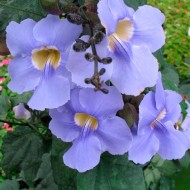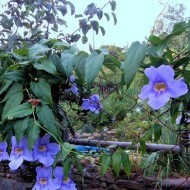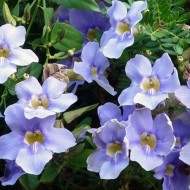The subtleties of successfully growing tunbergia from seeds at home
Content
Botanical Description of Tunbergia
Thunbergia is a tropical culture from the genus of lianas. Grown in garden plots or as a houseplant. Shoots up to 2.5 m long are densely covered with dark green, fleecy, heart-shaped leaves. During the flowering period, which begins in mid-summer, the liana is covered with many flowers of different shades, with a maximum diameter of 4 cm. Some varieties have a delicate aroma. The seeds ripen closer to winter and are small rough boxes of dark brown color and 4 mm in size.

Video "Features of growing tunbergia"
In this video, you will learn how to properly grow tunbergia, plant and care for it.
Popular in gardening species and varieties of flowers
Thunbergia has over 200 species growing in the wild. There are not so many cultivated varieties, and they are all divided into several types.
Multi-flowered, or grandiflora
The large-flowered tunbergia is native to India. A flower with very long, curly shoots (up to 8 m) and a powerful root system. Flexible branches are densely planted with wide lobed leaves, 17–20 cm long. Large flowers 7–9 cm in diameter are collected in small inflorescences. A highly decorative variety has a pale blue or lavender shade with a light heart.
Fragrant
This species is native to Australia. The highly branching liana grows up to 6 m in length, and when blooming, it is covered with single snow-white flowers 3-5 cm in diameter. The leaf plates are elongated oval, dark green above and slightly lighter, with white veins below. In total, there are two types of fragrant tunbergia:
- Smooth. It is odorless and only grows up to 2 m. Grown as a houseplant. Differs in abundant flowering.
- Dressed. The snow-white flowers of this variety have a barely noticeable greenish tint, covered with a small downy.
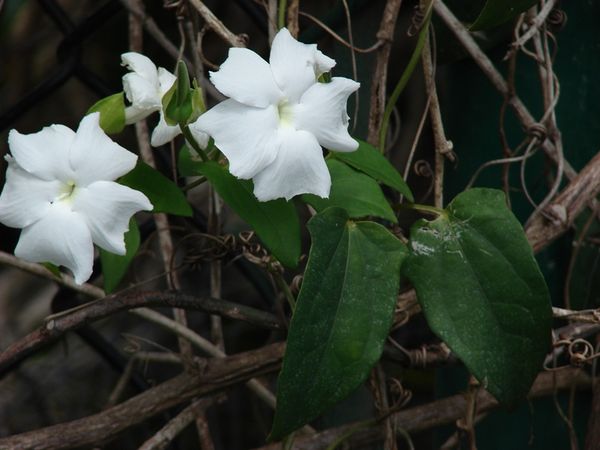
Mysore, or Mizorin
The rarest variety that came to us from India. Outwardly, the plant resembles an orchid. Tubular flowers, painted in yellow, orange and dark red tones, form clusters hanging down to 0.5–1 m. The size of a vine can reach 6 m. Dark green leaves are glossy, elongated, with pointed tips.
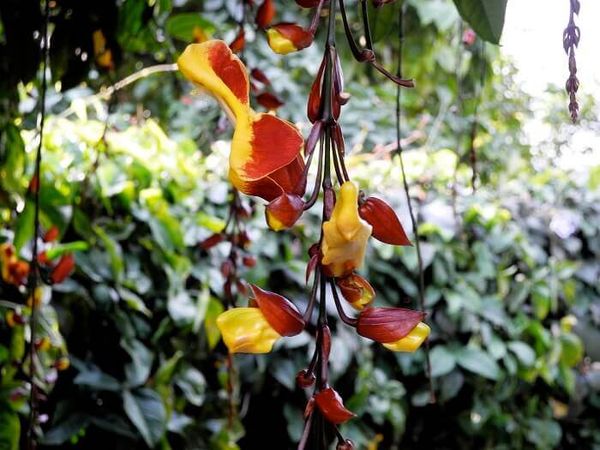
Winged
The most common species, native to Madagascar. The maximum length of a liana is no more than 2 m. The leaf plates are heart-shaped, with carved edges, smooth on the top and covered with a short pile on the bottom. Flowers up to 4 cm in diameter form small inflorescences of different shades.
The most popular varieties of winged tunbergia are:
- Black-eyed Suzanne. Flowers are rich orange or yellow with a black core.
- African Sunset.Terracotta or brown-orange inflorescences.
- Express. Light yellow funnel-shaped flowers with a purple core.
- Minstrel. Snow-white tunbergia with a black "eye".

Growing tunbergia from seeds
At home, the vine is bred as an annual plant. Some growers grow a flower from seed. This is easy to do if you follow a few agrotechnical rules.
When to plant seedlings
Planting material for seedlings is sown from late winter to mid-spring. The earlier the seeds are planted, the stronger the young plant will be. The "May" sapling planted in open ground will give numerous shoots in a month, and by the beginning of August it will begin to bloom profusely.
Sowing seeds can also be done at the end of summer. For the winter, tunbergia provide comfortable conditions and additional lighting, and in the spring they are planted in a permanent place.
Preparation of soil and planting material
The seeds for planting must be fresh. To make them emerge faster, they are treated with a growth stimulant. As a rule, the planting material is pre-germinated. It is laid out on a damp paper towel and placed in a container with a tight-fitting lid. The landing can be done when small roots hatch. For a quick emergence of a vine, a soil mixture of leafy earth, fine sand, humus is suitable.
Sowing seeds
Planting material can be sown in containers or small cups. Large seeds are placed at a depth of 1.5 cm at a distance of 5 cm from each other, sprinkled with earth on top, and then moisten the soil. The container is covered with glass or polyethylene and placed in a lighted place at a temperature of + 20 ... + 22 ° C. After 10-14 days, when the first shoots appear, young seedlings are opened.
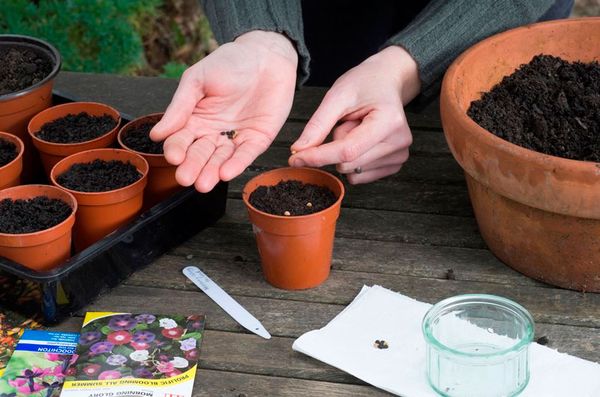
Seedling care
In order for the seedlings to develop normally, they need to be watered regularly. Do not allow the soil to dry out or moisture stagnation. To accelerate growth, nitrogen fertilizers can be applied, but then flowering will come later than the due date. If the seedlings are too close, they are thinned out. When the “young” reaches 15 cm, the top is pinched to stimulate the appearance of lateral shoots.
Landing in open ground
Planting in open ground is carried out no later than May-June. Tunbergia will feel most comfortable in a well-lit place without drafts. The plant loves fertile soil with good permeability.
Before planting, the earth is loosened, planting holes are made at intervals of 30 cm, and a support is dug in next to it. Having placed the seedlings in the pits, they are abundantly watered and mulched with dry grass.
Tunbergia care
Despite its origin, the tropical plant is not demanding to care for. In order for the "young" to acclimatize and grow faster, they create the necessary conditions for this:
- Watering. The soil under the vines should not dry out completely, so the tunbergia is watered regularly. The volume is increased only during flowering. To reduce the risk of root rot, a coconut substrate is placed under the plant.
- Humidity. At high temperatures or prolonged drought, the vine is moistened over the leaf. Do this in the evening, after sunset.
- Top dressing. Before budding begins, the plant is fed once a month. Complex formulations are used for fertilization. When flowering begins, the frequency is doubled. The last top dressing is applied with the onset of autumn.
- Pruning. Liana is regularly inspected for faded flowers or dry leaves. In order for tunbergia to bloom profusely, all dried parts must be removed in time. Weak lateral shoots are also cut out and young shoots are pinched to form a denser crown.
For the winter, flowers growing in pots or flowerpots are pruned, leaving 5 buds on each shoot.The cut sites are treated with an antiseptic. The plant is kept at a temperature of no more than + 15 ° C, periodically moistening the soil with a spray bottle. Vines growing in open ground are dug up and burned for the winter.
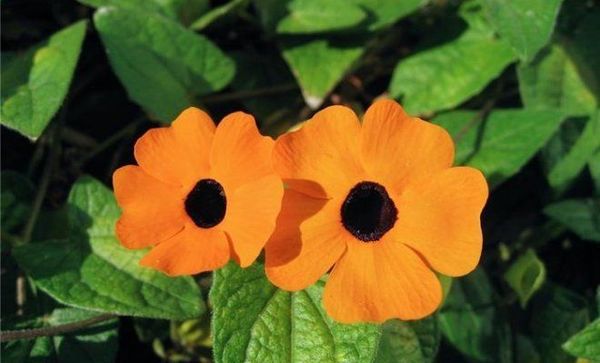
Protection against diseases and pests
Most often, tunbergia is susceptible to insect attacks. Spider mites, aphids, scale insects or whiteflies can settle on it. To combat parasites, flower growers recommend using "Actellik" or "Fitoverm". You can use the funds no more than 3-4 times with an interval of 1.5 weeks.
If the plant has suffered due to a fungal infection, it is treated with a targeted fungicide, after removing the affected areas.
Sometimes mold can appear on the leaf plates. This phenomenon is a consequence of too abundant watering. And if the leaves are very rare, then the tunbergia lacks lighting.
Thunbergia in landscape design
A strongly curly flower is good because it can be given any shape. It goes well with honeysuckle, ivy, cobea. Also, the plant is great for shading gazebos or greenhouses. Blooming vines can be used to make a hedge or to decorate an arch.
Ampel varieties are used for decorative design of terraces, flower beds, balconies. Fuchsia and asparagus are most often planted next to them. They can also decorate borders or create original flower arrangements.
Do not be afraid to start this exotic plant. Growing tunbergia is available to any grower. With proper care, flowers will delight you with abundant and vibrant flowering.

